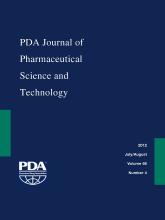Abstract
The recent developments on the use of e-pedigree to identify the chain of custody of drugs suggests the use of advanced track and trace technologies such as two-dimensional barcodes and radio frequency identification (RFID) tags. RFID technology is used mainly for valuable commodities such as pharmaceutical products while incorporating additional functionalities like monitoring environmental variables to ensure product safety and quality. In its guidance for the use of RFID technologies for drugs (Compliance Policy Guide Section 400.210), the Food and Drug Administration outlined multiple parameters that would apply to any study or application using RFID. However, drugs approved under a Biologics License Application or protein drugs covered by a New Drug Application were excluded mainly due to concerns about the effects of radio frequency radiation (thermal and/or non-thermal) on biologics. Even though the thermal effects of radio frequency on biologics are relatively well understood, there are few studies in the literature about the non-thermal effects of radio frequency with regards to the protein structure integrity. In this paper, we analyze the non-thermal effects of radio frequency radiation by exposing a wide variety of biologics including biopharmaceuticals with vaccines, hormones, and immunoglobulins, as well as cellular blood products such as red blood cells and whole blood-derived platelets as well as fresh frozen plasma. In order to represent the majority of the frequency spectrum used in RFID applications, five different frequencies (13.56 MHz, 433 MHz, 868 MHz, 915 MHz, and 2.4 GHz) are used to account for the most commonly used international frequency bands for RFID. With the help of specialized radio frequency signal-generating hardware, magnetic and electromagnetic fields are created around the exposed products with power levels greater than Federal Communications Commission–regulated limits. The in vitro test results on more than 100 biopharmaceutical products from eight major pharmaceutical companies as well, as different blood products, show no non-thermal effect by radio frequency radiation.
LAY ABSTRACT: Forthcoming requirements, such as the California Board of Pharmacy Track and Trace initiative regarding the use of e-pedigree to identify the chain of custody of drugs, suggest the use of advanced track and trace technologies such as two-dimensional barcodes and radio frequency identification (RFID) tags. When used for pharmaceuticals, RFID technology can support additional functionalities like monitoring temperature to ensure product safety. In its guidance for the use of RFID technologies for drugs, the Food and Drug Administration outlined multiple parameters that would apply to pilot studies using RFID while excluding drugs approved under a Biologics License Application or protein drugs covered by a New Drug Application due to concerns about the effects of radio frequency radiation on biologics. Even though the effects of radio frequency on biologics due to temperature changes are relatively well understood, there are few studies in the literature about other effects of radio frequency that can occur without a noticeable change in temperature. In this paper, we expose a wide variety of biologics including biopharmaceuticals to radio frequency radiation at different frequencies, as well as cellular blood products and plasma to high frequency radiation. The in vitro test results show no detectable effect due to radio frequency radiation.
- Radio frequency identification (RFID)
- e-pedigree
- Track-n-trace
- Tag
- Biologics
- Biopharmaceuticals
- Vaccine
- Hormone
- Immunoglobulin (antibody)
- Blood
- Non-thermal effects
- FDA
- Guidance
- Regulation
- © PDA, Inc. 2012
PDA members receive access to all articles published in the current year and previous volume year. Institutional subscribers received access to all content. Log in below to receive access to this article if you are either of these.
If you are neither or you are a PDA member trying to access an article outside of your membership license, then you must purchase access to this article (below). If you do not have a username or password for JPST, you will be required to create an account prior to purchasing.
Full issue PDFs are for PDA members only.
Note to pda.org users
The PDA and PDA bookstore websites (www.pda.org and www.pda.org/bookstore) are separate websites from the PDA JPST website. When you first join PDA, your initial UserID and Password are sent to HighWirePress to create your PDA JPST account. Subsequent UserrID and Password changes required at the PDA websites will not pass on to PDA JPST and vice versa. If you forget your PDA JPST UserID and/or Password, you can request help to retrieve UserID and reset Password below.






